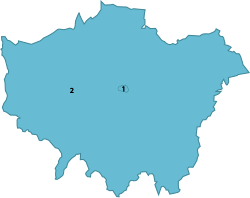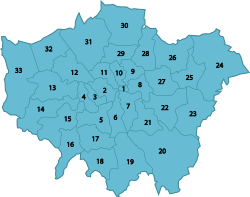
Back Groter Londen AF Gran Londres AN لندن الكبرى Arabic لندن الكبرى ARZ Gran Londres AST Böyük London AZ London Raya BAN Вялікі Лондан BE Вялікі Лёндан BE-X-OLD Голям Лондон Bulgarian
Greater London is an administrative area in England,[4] coterminous with the London region, containing most of the continuous urban area of London. It contains 33 local government districts: the 32 London boroughs, which form a ceremonial county also called Greater London, and the City of London. The Greater London Authority is responsible for strategic local government across the region, and regular local government is the responsibility of the borough councils and the City of London Corporation. Greater London is bordered by the ceremonial counties of Hertfordshire to the north, Essex to the north-east, Kent to the south-east, Surrey to the south, and Berkshire and Buckinghamshire to the west.
Greater London has a land area of 1,572 km2 (607 sq mi) and an estimated population of 8,866,180 in 2022.[3] The ceremonial county of Greater London is only slightly smaller, with an area of 1,569 km2 (606 sq mi) and a population of 8,855,333 in 2022.[5] The area is almost entirely urbanised and contains the majority of the Greater London Built-up Area, which extends into Hertfordshire, Essex, Kent, Surrey, and Berkshire and in 2011 had a population of 9,787,426. None of the administrative area, region, or ceremonial county hold city status, but the City of London and City of Westminster separately do. The area was historically part of Middlesex, Essex, Surrey, Kent and Hertfordshire.
The River Thames is the defining geographic feature of the area, entering it near Hampton in the west and flowing east before exiting downstream of Dagenham. Several tributaries of the Thames flow through the area, but are now mostly culverted and form part of London's sewerage system. The land immediately north and south of the river is flat, but rises to low hills further away, notably Hampstead Heath, Shooter's Hill, and Sydenham Hill. The area's highest point is Westerham Heights (245 m (804 ft)), part of the North Downs. In the north-east the area contains part of Epping Forest, an ancient woodland.
The City of London has had its own government since the Anglo-Saxon period. The first London-wide directly elected local government was the London County Council, established for the County of London in 1889, which covered the core of the urban area. In 1965 the county was abolished and replaced by Greater London, a two-tier administrative area governed by the Greater London Council, thirty-two London boroughs, and the City of London Corporation.[6] The Greater London Council was abolished in 1986, and its responsibilities largely taken over by the boroughs. The Greater London Authority was formed in 2000.
- ^ "Mid-2022 population estimates by Lieutenancy areas (as at 1997) for England and Wales". Office for National Statistics. 24 June 2024. Retrieved 26 June 2024.
- ^ UK Census (2021). "2021 Census Area Profile – London Region (E12000007)". Nomis. Office for National Statistics. Retrieved 1 June 2024.
- ^ a b "Mid-Year Population Estimates, UK, June 2022". Office for National Statistics. 26 March 2024. Retrieved 3 May 2024.
- ^ "London Government Act 1963 - Latest Available". legislation.gov.uk. Archived from the original on 29 October 2021. Retrieved 12 October 2021.
- ^ "Mid-2022 population estimates by Lieutenancy areas (as at 1997) for England and Wales". Office for National Statistics. 24 June 2024. Retrieved 26 June 2024.
- ^ "London Government Act 1963 - Latest Available". legislation.gov.uk. Archived from the original on 29 October 2021. Retrieved 12 October 2021.





